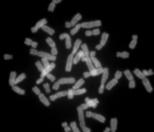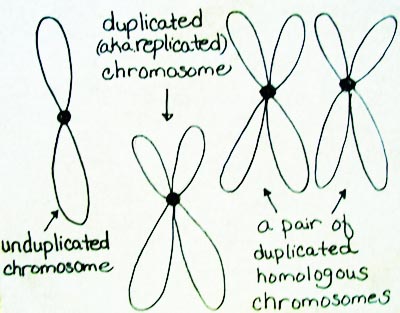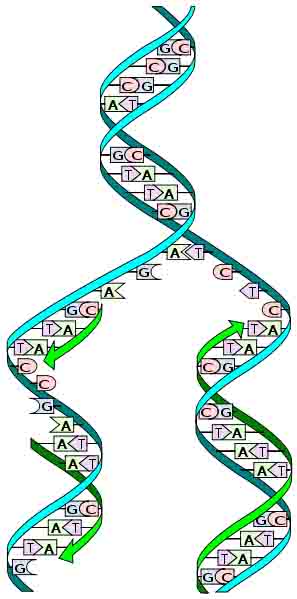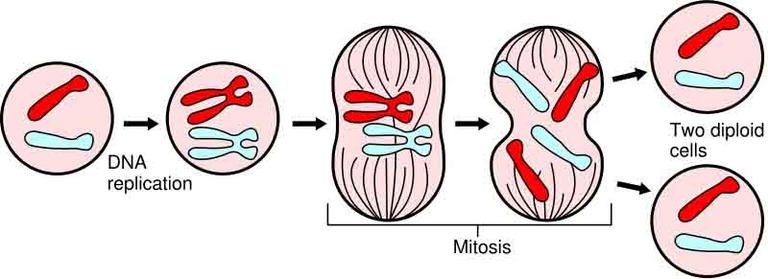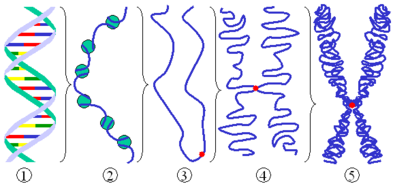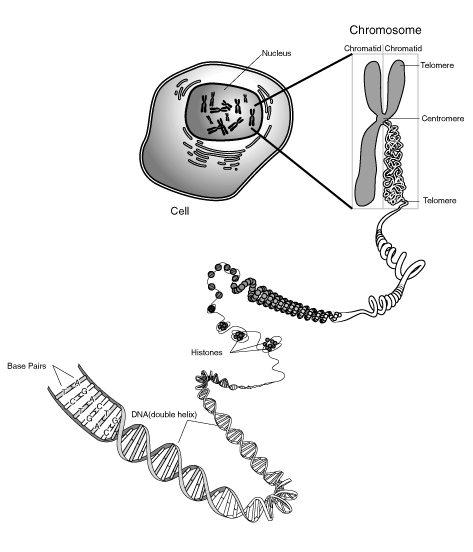 | ||||
Genetics Terminology
Duplicated & Homologous Chromosomes
CLASS NOTES from Science Prof Online
Article Summary: Sexual reproducers have two sets of homologous chromosomes; one from mom and one from dad. What is the difference between homologous and duplicated chromosomes?
Duplicated vs. Homologous Chromosomes
- DNA Condensing: Most of the time, the DNA molecules in each of your cells do not look like chromosomes, but instead are in very long strands called chromatin. When the DNA is undergoes the process of replication, it must be in these long chromatin strands, so that the double-stranded molecule can be "unzipped" and read. But when the cell prepares to divide, it must “pack” its DNA for the move. So prior to cell division, the chromatin condenses. This prevents the DNA from getting tangled up when it is sorted into two cells during mitosis.
- Copying DNA: Before a cell divides, it must make a copy of its DNA (nucleic acid) so that each daughter cell has a complete copy of genetic information. Each individual DNA molecule is the material of one chromosome, and the process of duplicating or copying the DNA is called replication.
Homologous, Duplicated Chromosomes
This replicated DNA molecule, in its condensed form, is now referred to as a chromosome. But, remember, there are two copies attached to each other until the genetic material is split so that each new cell gets a copy. During prophase and metaphase of mitosis, we have 22 pairs of homologous, duplicated autosomes.
 | ||||||
SPO VIRTUAL CLASSROOMS
Homologous Chromosomes
Most of the cells in our bodies are somatic, the cells that aren't eggs or sperm. Somatic cells have a diplod (2n) chromosome number, meaning that chromosomes come in pairs called homologues.
You have free access to a large collection of materials used in a college-level introductory Cell Biology Course. The Virtual Cell Biology Classroom provides a wide range of free educational resources including Power Point Lectures, Study Guides, Review Questions and Practice Test Questions.
Genetics Sources & Resources
- Genetics: Tour of the Basics, Genetic Science Learning Center, University of Utah.
- Chromosome Structure animation from John Kyrk.
- Genetic Terminology: Chromosomes & Sister Chromatids.
- How the Cell Cycle Works, animation & quiz from McGraw-Hill.
- Mitosis & Cytokinesis, animation & quiz from McGraw-Hill.
- Unique Features of Meiosis animation & quiz from McGraw-Hill.
- Comparison of Mitosis & Meiosis animation & quiz from McGraw-Hill.
- Cell Division: Mitosis Lecture Main Page, Virtual Cell Biology Classroom.
- Cell Division: Meiosis Lecture Main Page, Virtual Cell Biology Classroom.
Page last updated: 10/2015
The SPO website is best viewed in Microsoft Explorer, Google Chrome or Apple Safari.
 | ||||||
SPO is a FREE science education website. Donations are key in helping us provide this resource with fewer ads.
Please help!
(This donation link uses PayPal on a secure connection.)
Every somatic cell in your body has 46 chromosomes. You received a set of 23 from your mother’s egg and a set of 23 via your father’s sperm, and now these chromosomes are the genetic material inside nearly every cell of your body.
Two of your chromosomes are sex chromosomes (XX in females; XY in males). The other 22 pairs are called autosome. Humans have 22 pairs of autosomes. Each pair are considered homologous,
and carry the same genes in the same order, but the alleles for each trait may not be the same. An allele is one of two or more alternative forms of a gene that are found at the same locaion on homologous chromosomes.
Different levels of DNA condensation: (1) Single DNA strand. (2) Chromatin strand (DNA with histones). (3) Chromatin during interphase with centromere.
(4) Condensed chromatin during prophase. (Two copies of the DNA molecule are now present) (5) Completely condensed chromosome during metaphase.
DNA molecule replicating: Strands separating so that the DNA can be read and replication can occur.
You have FREE access to a large collection of materials used in a college-level introductory biology course. The Virtual Biology Classroom provides a wide range of free educational resources including PowerPoint Lectures, Study Guides, Review Questions & Practice Test Questions.
Karyotype of a human female, showing 22, duplicated, homologous pairs of autosomes, and two duplicated X chromosomes.
Cell Division & DNA Replicaiton
- Cells Divide to Make More Cells: During the cell cycle, somatic cells grow and divide. In this process, called mitosis, a single cell ('parent cell') splits into two identical ‘daughter cells’.
 | ||||
WHICH GENETIC TRAITS DO YOU HAVE?
